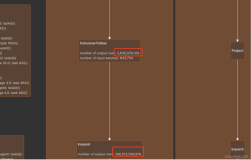分组集(Grouping Sets)是多个分组的并集,用于在一个查询中,按照不同的分组列对集合进行聚合运算,等价于对单个分组使用“union all”,计算多个结果集的并集。使用分组集的聚合查询,返回的select 子句相同,由于select子句只能引用分组列,因此,在单个分组中缺失的分组列,TSQL返回NULL值。
TSQL使用 group by 子句分组,有4种不同的语法:
- group by a,b
- group by rollup(a,b)
- group by cube(a,b)
- group by grouping sets((),(a),(a,b),rollup(a,b),cube(a,b))
一,分组集
1,单个分组
以集合的视角来看 “group by a,b” 子句,等价于 “group by grouping sets (a,b)”,(a,b) 是单个分组,是集合相乘的结果:(a)*(b)=(a,b) ;
2,预定义的分组集(grouping sets):
- rollup(a,b) :预定义的分组集是(),(a),(a,b);
- cube(a,b) :预定义的的分组集是(),(a),(b),(a,b);
3,使用grouping sets 自定义分组集
单个分组的集合是分组集, 分组集 grouping sets((a),(a,b)) :表示两个分组 (a,b),(a) 的并集,查询的结果等价于:
group by (a,b) union all group by(a)
4,分组集运算
分组集运算法则:
- () :表示空集,整个集合作为一个分组;任何集合和空集相乘,结果是:(a)*()=(a);
- 分组集相乘:两两组合,例如,{(a),(b)}*{(c),(d)}={(a,c),(a,d),(b,c),(b,d)}
- 集合相乘时,不会去重:例如,{(a),(b)}*{(),(a)}={(a),(a,a),(b),(b,a)}
- (a,a)等价于集合(a):例如,{(a),(b)}*{(),(a)}={(a),(a),(b),(b,a)}
- group by是分组集相乘:例如, group by grouping sets((a),(b)),c 等价于 group by grouping sets((a,c),(b,c))
- grouping sets是分组集求并集,不会去重:例如,grouping sets((a),(a)) 等价于 grouping sets(a) union all grouping sets(a)
4.1,解析:grouping sets(rollup(a,b),b) 等价于 group by cube(a,b)
解析过程:rollup(a,b)定义的分组集是(),(a),(a,b),并上分组(b),就是:((),(a),(a,b),(b)),等价于cube(a,b)。
4.2,解析 group by grouping sets((a),(b)), rollup(a)
解析过程:grouping sets((a),(b)),定义两个分组集合((a),(b)),rollup(a)定义两个分组集合:((),(a)),
两个分组集进行相乘:{(a),(b)}*{(),(a)}={(a),(a),(b),(b,a)},集合相乘时,不会去重;
二,示例
1,创建示例数据
create table dbo.Inventory ( Item int not null, Color varchar(10) not null, Quantity int not null, Store int not null )
2,将整个集合作为一个分组,grouping sets 是()
select null as Item, null as Color,SUM(Quantity) as TotalQuantity,COUNT(Store) as Stores from dbo.Inventory --等价于 select null as Item, null as Color,SUM(Quantity) as TotalQuantity,COUNT(Store) as Stores from dbo.Inventory group by grouping sets(())
3,grouping sets是(a)
select Item,null as Color,SUM(Quantity) as TotalQuantity,COUNT(Store) as Stores from dbo.Inventory group by Item order by Item --等价于 select Item,null as Color,SUM(Quantity) as TotalQuantity,COUNT(Store) as Stores from dbo.Inventory group by grouping sets( (Item)) order by Item
4,grouping sets 是(a,b)
select Item,Color,SUM(Quantity) as TotalQuantity,COUNT(Store) as Stores from Inventory group by Item,Color order by Item,Color --等价于 select Item,Color,SUM(Quantity) as TotalQuantity,COUNT(Store) as Stores from Inventory group by grouping sets( (Item,Color)) order by Item,Color
5,分组集是:rollup(a,b),或 grouping sets是((),(a),(a,b))
--rollup(a,b)的grouping sets是(),(a),(a,b) select Item,Color,SUM(Quantity) as TotalQuantity,COUNT(Store) as Stores from dbo.Inventory group by ROLLUP(Item,Color) order by Item,Color --等价于 select Item,Color,SUM(Quantity) as TotalQuantity,COUNT(Store) as Stores from dbo.Inventory group by grouping sets((),(Item),(Item,Color)) order by Item,Color
6,分组集是:cube(a,b),或grouping sets是(),(a),(b),(a,b)
--cube(a,b)的grouping sets是(),(a),(b),(a,b) select Item,Color,SUM(Quantity) as TotalQuantity,COUNT(Store) as Stores from dbo.Inventory group by ROLLUP(Item,Color) order by Item,Color --等价于 select Item,Color,SUM(Quantity) as TotalQuantity,COUNT(Store) as Stores from dbo.Inventory group by grouping sets((),(Item),(Color),(Item,Color)) order by Item,Color
7,对rollup(a,b),使用单个分组和union来实现
--rollup(a,b)的grouping sets是(),(a),(a,b) select Item,Color,SUM(Quantity) as TotalQuantity,COUNT(Store) as Stores from dbo.Inventory group by ROLLUP(Item,Color) order by Item,Color --等价于 select null as Item, null as Color,SUM(Quantity) as TotalQuantity,COUNT(Store) as Stores from dbo.Inventory union ALL select Item,null as Color,SUM(Quantity) as TotalQuantity,COUNT(Store) as Stores from dbo.Inventory group by Item union ALL select Item,Color,SUM(Quantity) as TotalQuantity,COUNT(Store) as Stores from dbo.Inventory group by Item,Color
8,对cube(a,b),使用单个分组和union来实现
--cube(a,b)的grouping sets是(),(a),(b),(a,b) select Item,Color,SUM(Quantity) as TotalQuantity,COUNT(Store) as Stores from dbo.Inventory group by cube(Item,Color) order by Item,Color --等价于 select null as Item, null as Color,SUM(Quantity) as TotalQuantity,COUNT(Store) as Stores from dbo.Inventory union ALL select Item,null as Color,SUM(Quantity) as TotalQuantity,COUNT(Store) as Stores from dbo.Inventory group by Item union ALL select null as Item,Color,SUM(Quantity) as TotalQuantity,COUNT(Store) as Stores from dbo.Inventory group by Color union all select Item,Color,SUM(Quantity) as TotalQuantity,COUNT(Store) as Stores from dbo.Inventory group by Item,Color
9, cube(a,b)的等价分组集是:grouping sets(rollup(a,b),b),或grouping sets((),(a),(a,b),(b))
--cube(a,b)的组合是(),(a),(b),(a,b) select Item,Color,SUM(Quantity) as TotalQuantity,COUNT(Store) as Stores from Inventory group by CUBE( Item,Color) order by Item,Color --等价于 select Item,Color,SUM(Quantity) as TotalQuantity,COUNT(Store) as Stores from dbo.Inventory group by grouping sets((),(Item),(Color),(Item,Color)) order by Item,Color --等价于 select Item,Color,SUM(Quantity) as TotalQuantity,COUNT(Store) as Stores from dbo.Inventory group by grouping sets(rollup(Item,Color),(Color)) order by Item,Color
10,分组集相乘,结果集不去重
解析 grouping sets((a),(b)), rollup(a)等价于 grouping((a),(a),(b),(b,a))
解析过程是:grouping sets((a),(b)), 定义两个分组集是(a),(b),rollup(a)定义两个分组集是:(),(a)
对这个分组集进行集合乘法运算:{(a),(b)}*{(),(a)}={(a),(a),(b),(b,a)}
select Item,Color,SUM(Quantity) as TotalQuantity,COUNT(Store) as Stores from dbo.Inventory group by grouping sets((Item),(Color)),rollup(Item) order by Item,Color --等价于 select Item,Color,SUM(Quantity) as TotalQuantity,COUNT(Store) as Stores from dbo.Inventory group by grouping sets((Item),(Color),(Item,Item),(Color,Item)) order by Item,Color
解析: grouping sets((a,b)),rollup(a)
解析过程:grouping sets((a,b)),定义分组集(a,b),rollup(a)定义分组集:{(),(a)},对这两个分组集合进行集合乘法运算:(a,b)*{(),(a)}={(a,b),(a,b)},实际上是两个相同的group by grouping sets((a,b)) 进行 union all 运算求并集。
select Item,Color,SUM(Quantity) as TotalQuantity,COUNT(Store) as Stores from dbo.Inventory group by grouping sets((Item,Color)),rollup(Item) order by Item,Color --等价于 select Item,Color,SUM(Quantity) as TotalQuantity,COUNT(Store) as Stores from dbo.Inventory group by grouping sets((Item,Color),(Color,Item)) order by Item,Color
三,分组集用法总结
1, cube和rollup 预定义grouping sets,
- rollup(a,b):预定义的grouping sets是(),(a),(a,b);
- cube(a,b):预定义的grouping sets是(),(a),(b),(a,b);
2,集合的乘法
group by a,b 表示的是分组集(a),(b)的乘法:(a)*(b)=(a,b)
group by grouping sets((a),(b)),c 表示的是分组集((a),(b)),(c)的乘法:((a),(b))*(c)=((a,c),(b,c))
3,集合的并集
grouping sets((a),(b)),表示的是分组集的并集,等价于:
grouping sets(a) union all grouping sets(b)
参考文档:



![报错:[Err] 1055 - Expression #1 of ORDER BY clause is not in GROUP BY clause and contains nonaggregat](https://ucc.alicdn.com/pic/developer-ecology/738a5899ebc049ee934978bfeeca615d.png?x-oss-process=image/resize,h_160,m_lfit)
